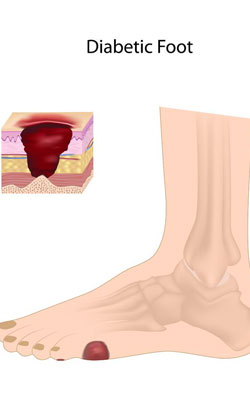
A Diabetic foot is something that shows any pathology that directly results from diabetes mellitus or any chronic complication of diabetic mellitus. The presence of such characteristically diabetic pathology is known as diabetic foot syndrome. It is common mostly in people with type-1 and type-2 diabetes.
The principal causes for this ailment are peripheral neuropathy, ulceration, infection and vascular compromise. These are usually associated with trauma or foot deformity that leads to the risk of lower limb amputation. It can also lead to loss of sensitivity in the foot, and so injuries go unnoticed. Most of these foot conditions happen because of nerve damage, also known as neuropathy. Diabetic patients run the risk of losing a leg, 25 times more than those without diabetes.
Causes of Diabetic Foot
Foot problems in diabetic patients take place by the interaction of multiple component causes.Peripheral neuropathy is one of the situations when the sensation in the feet is lost which result in injuries being unnoticed and leads to foot ulceration.Foot deformity is a condition which results in the formation of calluses on weight bearing areas.Arterial insufficiency is a condition in which blood flow to the feet become low and it slows down the process of wound healing.
This increases the risk of infection. Impaired resistance to infection aggravates the risk of infection leading to amputation. Charcot’s joint is a rare and serious disease which is frequently related to underlying neuropathy.Diabetic foot problems are not usual in patients below 40 years of age. It increases after 40 years and is more in those aged 50 years are older. In addition, it is observed that men with diabetes have increased risk of foot amputation or ulcers than with women with diabetes.
Symptoms
The early warning signs of diabetic foot are a wound or sore on the foot that does not heal, with a good chance of infection which makes it worse. Dizziness, changes in digestion, urination or changes in the colour or shape of foot are common symptoms found in diabetic foot. These symptoms do not always point to nerve damage, but they are signals to other problems that need to be treated. Even minor wounds on the feet can turn into ulcers.
Tests for diabetic foot
A medical test includes a thorough examination of health history of the patient and physical conditions and may include laboratory tests, x-ray studies of legs and consultation with specialists.At the outset, the doctor would gather information about the patient’s symptoms and vital signs like temperature, blood pressure, pulse and resipotary rate. Examination of sensation and circulation in the feet and legs, and detailed check-up for other problem areas also will be performed.
Depending on the severity, the doctor may opt for laboratory tests. Lab tests includes x-rays, ultrasound scan etc. as needed.
Treatment
Diabetic foot problems are difficult to treat as it can become worse very quickly. The treatment depends upon the condition in which the patient is experiencing diabetic foot. Angiogram, antibiotics or reference to a suitable wound care center are the common treatments for diabetic foot.





